
10.Implementation
.pdf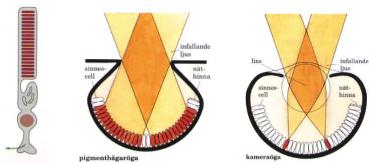
10.5. BIOLOGICAL CONTROL |
289 |
Figure 10.10: Schematic picture of a vision sensors, a rod cell in the retina (a), a primentbagar;ga (b) eye and a lens eye (c). These cells have photosensitive discs which contain the light-sensitive pigment rhodopsin. Light generates an electric signal which is transmitted via nerve cells.
¯lled with liquid. A gelatinous massm called the cupola, is inserted in the canal. Hair cells in the cupola detect bending which is an indication of the angular velociy of the head. The ultricle is provided with a device consisting of a membrane with embedded stones supported by a gelatineous mass with haircells. This device acts like a damped inverted pendulum and provides information about tilt and acceleration. Notice that the haircells are the primary sensory devices. The primary sensors in biological systems are often combined with other cells tro form signaling cascades. Such systems can have very high gain. The olefactory system of a dog can react to a few molecules only. The signaling cascades can also adapt to very large signal ranges.
Actuation
There are several types of actuators in biological systems. Muscles is one type of actuators which makes it possible to exert external forces. Humans have three types of muscles, sceletal muscles, smooth muscles and heart muscles. The smooth muscles are present in internal organs, such as the digestive tract, veins and arteries. They are composed of thing long cells with one nucleus, see Figure 10.13.
The sceletal muscles are used to move the joints in the body. These muscles consists of a large number of muscle ¯bres which large cells with many nuclei, see Figure 10.13. The cells are typically several centimeters long with diameters around 50 ¹m. The ¯bres have an intriguing structure
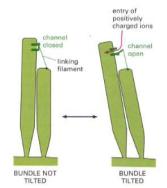
290 |
CHAPTER 10. IMPLEMENTATION |
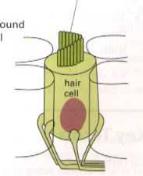 .
.
Figure 10.11: Schematic picture of a hair cell in the inner ear (left) and an enlargement (right) which shows the detection mechanism.
with many myo¯brils which permit contraction of the muscle. Since the muscles operate by contraction bidirectional motion is generated by using pairs of muscles. There are also stretch sensors in the muscles which are used for feedback.
The cardiac muscles are specialized cells that produce the hart beat. Neighboring cells interact electrically to create the periodic motion required to pump the blood.
The smooth muscles and the heart muscle are controlled by the autonomous nerve system. The sceletal muscles can be controlled conciously.
Apart from muscles there which generate forces there are also actuators in the form secretary cells that act by secreting hormones and other substances into the blood.
Communication and Computing
There are several ways to communicate in biological systems. Hormones produced in glands can be distributed widely by secretion into the bloodstream. Molecules can di®use to neighboring cells. There are special mechanisms for direct membrane to membrane contacts.
Neurons, see Figure ??, are special cells for computing and communication. The neuron consists of a cell body, dendrites and an axon. The cell body is nucleous which contains the biochemical system essential for to keep the cell alive. The dendrites are tree-like tubes that extend from teh cell
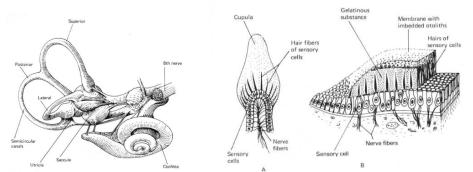
10.5. BIOLOGICAL CONTROL |
291 |
.
Figure 10.12: Schematic picture of the vestibular system (left), the cupola which is the primary sensor based on hair cells (middle) and the utricle (right).
body. They serve as receptors for incoming signals. The axon is the the output device that serves as a communication device to other neurons. The output singal of a neuron consists of pulses which are transmitted electrically along the axon. Some axons are provided with a sheath, which gives faster signal transmission. The axon ends with terminal ¯bres so that it can be connected to many other neurons. Information to other neurons is transmitted at synapses. The axon terminals are terminal buttons which contain tiny structures called vesicles. A vesicle can hold thousands of molecules which can be released into the receiving neuron. Transmission occurs when an electrical pulse reaches the buttons. The released molecules change the postsynaptic potential in the body of the receiving cell. A pulse is generated when the cell voltage reaches a threshold. Some inputs are excitory, they stimulate pulse generation, other inputs are inhibitory.
A human brain is believed to have around 1011 neuron. A typical neuron may have from 103 to 104 synapses. The axons can be very long, more than 1 m in the human. Even if the basic structure of the neurons are similar they can have di®erent structure and di®erent functions.
²Explain how computations can be made with ¯rst order systems and summation.
Control System For Muscle Contraction
How sensing, actuation and computing is combined in a system can be illustrated by the components involved in the knee re°ex. Contraction of
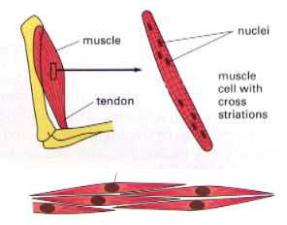
292 |
CHAPTER 10. IMPLEMENTATION |
Figure 10.13: Sceletal muscles (top) and smooth muscles (bottom).
muscles are initiated by special motoneurons, see Figure ??. The axons of these neurons are covered with glia cells, which increases the speed of signal transmission. The axons are connected to the muscle cells. The muscle cells also have stretch sensitive neurons that are imbedded in the muscles. When the knee is hit the stretch sensitive neuron is excited. The signal is passed to many motoneurons in the spinal cord as illustrated in Figure 10.15. The motoneurons activate the muscles to generate the rapid knee kick. Information is also sent to the brain as indicated in Figure 10.15. human.
Mathematical Models
Neurons can be viewed as multi-input single-output systems. The primary signal forms is pulses or spikes. There are inhibitory and exhibitory inputs. A crude model is obtained by giving the average pulse rate as a function of the average pulse rates of the excitory and inhibitory inputs.
A simple static model gives the average pulse rate as a function of the postsynamptic potential. Many forms have been suggested, one example is the Naka-Rushton model
|
|
aun |
|
|
|
y = f (u) = |
|
|
; |
for u ¸ 0 |
|
|
bn +un |
|
|||
|
(0; |
|
for u < 0 |
(10.9) |
|
u = §kek ¡ §kik
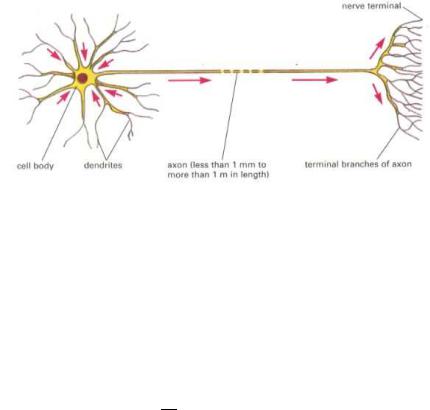
10.5. BIOLOGICAL CONTROL |
293 |
Figure 10.14: Schematic picture of a neuron. From Alberts et al 1997.
where y is the pulse rate of the output, and u is the stimulus intensity. The total stimulus activity is di®erence between the the sum of the pulse rates from the excitory inputs ek and the pulse rates of the inhibitory connections ik. The parameter a is the maximum pulse rate, and b the input stimuli which gives half the maximum rate.
A simple dynamical model is obtained by adding ¯rst order dynamics, hence
dy |
= ®(y ¡ f (u)) |
(10.10) |
dt |
The model given by Equations (10.9) and (10.10) can be represented by the simple diagram in Figure 10.16.
The models given by Equations (10.9) and (10.10) are simple models that capture some of the input-output of the neuron but they are not closely related to physiology. The Hodgkin-Huxley model is more complicated that captures more of the physiology. This model is describes the complicated phenomena in the cell membrane of the neuron. The key element is to account for passage of sodium and postassium ions across the membrane. The cell body is approximately 10 times richer in potassium and about 10 times leaner in sodium. There is leakage by di®usion through the cell membrane. The concentration di®erences is maintained by pumps for sodium and potassium. The pumps are in°uenced chemically by the transmitter molecules secreted by the vesicles. Di®erent synapses have di®erent e®ects. A consequence of the concentration di®erences inside and outside the cell is that the potential of the cell is about 70 mV negative relative to the external liquid.
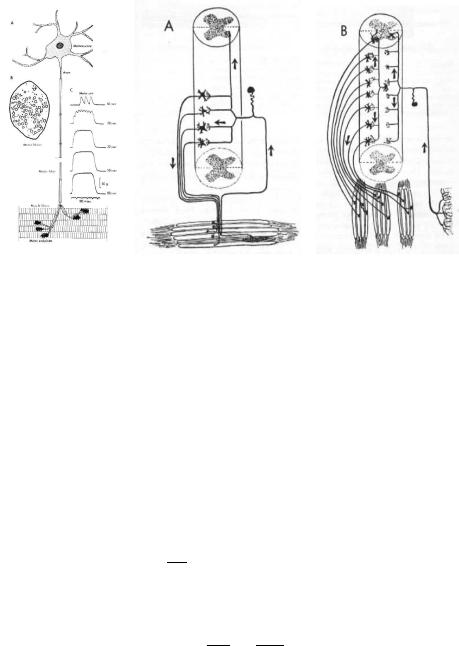
294 |
CHAPTER 10. IMPLEMENTATION |
Figure 10.15: Schematic picture of a motoneuron (left), schematic diagram of the pathways involved in the knee re°ex (middle) and the pathways for reaction to other stimuli (right).
Figure 10.16: Block diagram of the simple neuron models given by Equations (10.9) and (10.10). The inputs and the outputs represent average pulse rates.
The Hodgkin-Huxley equation is a charge balance for the cellmembrane. Let V be the potential di®erence across the cell membrane, IN a, IK the currents generated by the sodium and potassium pumps and Il the leakage
current. A charge balance then gives |
|
||
C |
dV |
= ¡IN a ¡ IK ¡ Il |
(10.11) |
dt |
|||
The currents are given by I = c(V ¡ E) where c is the conductance and E the equilibrium potential for the ions which is given by Nernst's law
E = RT log Cout zF Cin
where Cin and Cout are the concentrations inside and outside the cell, z the charge of the ion, R and F the thermodynamic gas constant and F the Faraday constant. The ion concentrations also obey di®erential equations. The
10.6. SUMMARY |
295 |
net result is a set of four nonlinear di®erential equations. These di®erential equations capture many important properties observed in real neurons.
²The HH model predicts generation of limit cycles spikes.
²Computation can be made with ¯rst order systems instead of integrators.
²Why two signal channels inhibitory and excitatory
²Di®erences and changes.
²Muscles of di®erent types
²Sensors with derivative action
²Gain changes and adaptation
10.6Summary
²Why is pulses used as a signal form in biological systems
²Why is electorchemistry not used more for sensors
²Why stable ¯rst order systems instead of integrators?
In this section we have described how control systems are implemented. There are four separate functions: sensing, actuation, communication and computing. It has been shown that the functions can be implemented using a wide variety of technologies. It is interesting to observe that feedback plays an essential role in sensing, actuation and computing. By exploiting the nice properties of feedback it is possible to obtain systems with well de¯ned properties from components with highly variable nonlinear characteristics. For example it is possible to optain precise analog computing from linear passive components and highly nonlinear ampli¯ers. Pulses are used in devices such as relay based temperature controllers, Figure ??, the deltasigma modulator, Figure ?? and in biological system, Figure ?? both as devices for computing and communication. There is however very little theory available for such systems. It is also interesting to observe that there is a super¯cial similarity between analog and neural systems in the sense that multi-input single output devices play a central role as summers and integrators in analog systems and as neurons in biological systems. There are however also signi¯cant di®erences. Integrators in ananlog are identical
296 |
CHAPTER 10. IMPLEMENTATION |
but neurons can di®er signi¯cantly. There is also a major di®erence in complexity. A large analog system may havee 100 integrators with 5 inputs each but a the human brain has 1011 neurons and a neuron may have 103 inputs.
10.7References
J.C. Eccles The understanding of the brain. Mc Graw Hill New York 1973. Alberts, B and D. Bray and A. Johnson and J. Lewis and M. Ra® and K.
Roberts and P. Walter Essential cell biology An introductin to the molecular biology of the cell Garland Publishing Inc New York 1997
H.R. Wilson Spikes decisions and actions. Dynamical foundations of neuroscience. Oxford University Press, Oxford 1999
Scienti¯c American The Brain Freeman New York 1979.
D.H. McBurney and V. B. Collings Introduction to sensation/perception. Prentice hall Englewood Cli®s NJ 1977.
T. R. H. Sitzer The digital di®erential analyser. Chapman and Hall, London 1968.
